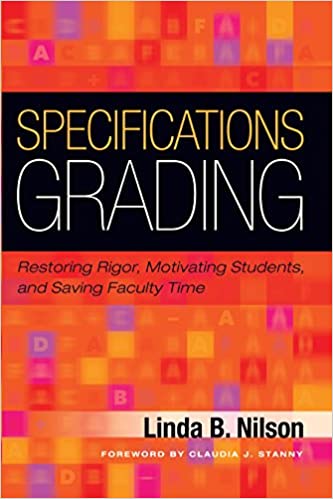
Have you ever considered a non-traditional approach to grading that involves your students? Students are more invested in their learning when given explicit choice and accountability. We have students from a wide variety of backgrounds and experiences. Offering creative grading alternatives encourages students to come as they are, reinforcing ourExceptional CareValue:UVU has a place for themto grow and succeed.
Often faculty complain about student motivation. Could it be students are highly motivated to learn but reject having their work reduced to points and a final grade that is often not reflective of their learning?
“The work of teaching shouldn’t be reduced to the mechanical act of grading or marking.” Jesse Stommel
Stommel, J. (2018, Mar 11). How to ungrade. Jessestommel.com. https://www.jessestommel.com/how-to-ungrade/
Renee Link, a Chemistry professor at the University of California, Irvine, says she is “uncomfortable with how grades become gatekeeping devices, causing graduate schools and potential employers to discount students’ scientific abilities. Plus, grades aren’t as accurate and precise a measure of student learning as many people assume. On top of that in large courses like mine, grades are routinely normalized to adjust for differences among graders. It’s just a terrible system.”
Arnaud, C. H. (2021, April 25). How an alternative grading system is improving student learning. Chemical Engineering News. https://cen.acs.org/education/undergraduate-education/alternative-grading-system-improving-student/99/i15
As you consider a grading method for your class, it is important to align it with course outcomes and your own teaching philosophy. Communicating and implementing an alternative grading method can initially be challenging; however, it becomes easier over time as you and your students acclimate and refine the process.
Grading Alternatives come in many forms; however, most are based on a combination of the principles outlined below in “Specifications Grading,” “Contract Grading,” and “Un-grading.”
Here is a quick comparison:
|
|
Specs Grading |
Contract Grading |
Un-grading |
|---|---|---|---|
|
Structure |
|
|
|
|
Setup Effort |
|
|
|
|
Grading |
|
|
|
|
Revisions Offered |
Yes |
Yes |
Yes |
|
Unique Elements |
|
|
|
|
Student Autonomy |
|
|
|
|
Final Grades |
|
|
|
Specifications grading sets specific grading criteria and outlines course deliverables into bundles according to final letter grades. Grading is often complete/incomplete or a combination with options to revise. Tokens provide awards or free passes, as determined by the instructor (such as free absences, skipping an assignment, dropping a lower grade assignment, or a point bump at the end if students don’t use any tokens). Students complete the specification bundles for the final grade they want.
“For our students, we should carefully select a limited number of requirements that are really important for them to focus on and for us to assess in a particular assignment or test.” -Linda B. Nilson p.58
While there are as many ways to do specifications grading as there are courses, the following is a basic outline.

The key part of specifications grading is that students can correct mistakes in a revision and not be penalized for trying something new. This enhances learning: we often learn most from our mistakes.
References:
Nilson, L. B., & Stanny, C. J. (2015). Specifications grading: restoring rigor, motivating students, and saving faculty time. Stylus.
Cox, J. (2020 Dec 3). Specs Grading – FCTL Winter 2020. YouTube. https://youtu.be/CqgpyXwQXLM
Quinones, M. P. (2021 January 3). Specifications grading. YouTube. https://youtu.be/3EEE8VLrBjc
Contract grading can be teacher structured or negotiated between teacher and an individual student or the whole class. Contracts outline the activities or tasks to be completed for a particular final letter grade. Final “A” grades often require additional quality work.
Once contracts are established, students have a very clear idea of what is required for the grade they want. Students are allowed to revise their work and renegotiate contracts. Grading is based on the labor expended and emphasizes progress over product.
Here is an example of an “A” contract from Ryan Cordell, University of Illinois.
“A” Contract
To contract for an “A” in this course, you agree to:
Cordell, R. (2019, December 7). How I contact grade. ryancordell.org https://ryancordell.org/teaching/contract-grading/
Cordell, R. (2019, January 18). Assignments. ryancordell.org https://s19tot.ryancordell.org/assignments/
Contract grading removes the subjectivity often entrenched in traditional grading and makes grading very transparent.
For example, Kevin DePew, Associate Professor, Department of English at Old Dominion University in Norfolk Virginia grades his student weekly entries as follows:
Note that the writing is not graded but rather the labor or effort expended.
Finley-Croswhite, A., O’Toole, J., Matheson, K., DePew K. (2021 October). Making the pitch for contract grading. Center for Faculty Development News. https://www.odu.edu/facultydevelopment/news/2021/10/making_the_pitch_for
Un-grading is a process of evaluating students' work, offering feedback, and allowing the student to revise. Eventually, 'lesser' performance (as determined by students, peers, and teachers) is replaced by better work, but without the grades. In the end, students select their final grade with justification of their learning and teacher oversight.
Heick, T. (2020, February). 12 Alternatives to letter grades in education. TeachThought.com. https://www.teachthought.com/pedagogy/alternatives-to-letter-grades/
Un-grading can be facilitated through a variety of alternative forms of assessment as suggested by Jesse Stommel (2021):
University of South Florida. (n.d.). Reflection template: DEAL model for critical reflection.https://www.usf.edu/engagement/documents/reflection.pdf
An example such as the following course assessment statement, based on one written by Jesse Stommel, can acclimatize students to your grading methodology and rationale and ease anxiety of students who may be hyper-focused on grades. It is very important to communicate your alternative grading strategies with students.
This course will focus on qualitative rather than quantitative assessment, something we'll discuss during the class, both with reference to your own work and the works we study. Although you will get a final grade at the end of the term, I will not be grading individual assignments but will instead ask questions and make comments that engage your work rather than simply evaluate it. You will also reflect carefully on your own work and the work of your peers. The intention is to help you focus on working in a more organic way, as opposed to working as you think you're expected to. If this process causes more anxiety than it alleviates, see me at any point to discuss your progress in the course to date. If you are worried about your grade, your best strategy is to join the discussions, do the readings, and complete the assignments. You should consider this course a 'busy-work-free zone.' If an assignment does not feel productive, we will find ways to modify, remix, or repurpose the instructions.
Stommel’s belief that “students are complex and deeply committed to their education is fueled by the thousands of self-reflection letters [he has] read throughout [his] career. What happens with almost every single student is that any assumption [he] might make about them is squashed by what they write about themselves and their work."
Stommel suggest four things you can do tomorrow to start un-grading:
Stommel, J. (2021, June 21). Ungrading: an introduction. Jessestommel.com. https://www.jessestommel.com/ungrading-an-introduction